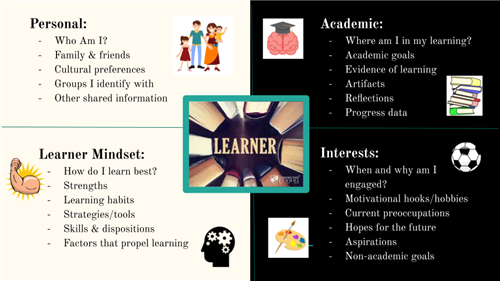- Sorrento Springs Elementary
- How We Learn
-
How We Learn
We support and promote a learner-centered mindset at Sorrento:
-
We value and teach the skills for design thinking and critical problem solving.
-
We employ project-based learning and hands-on experiences to actively involve students in the learning
-
We are patient with all learners and are willing to let them learn by failing forward
-
We want learning to extend beyond the school and build into our learners a desire to thrive and impact our ever-changing world
-
We have a willingness to dismantle centuries-old structures that have not allowed all learners to find success in school
-
We believe that learning is everywhere and our learning spaces need to be designed intentionally with flexibility in mind.
-
Even in just the first few months after launching our personalized learning school, we saw students giving TED talks, recording and sharing podcasts, developing museum exhibits, completing design challenges, leading clubs, creating new learning spaces, and so much more.
Our LEDs have identified three priority focus areas for our school: Learner Agency, Small Group Instruction, and Learner Profiles
Learner Agency
At Sorrento, we are focused on knowing our students and--more importantly--helping students know themselves. As we work hard to replace factory-model schools with personalized, student-centered learning experiences, knowing our students has taken on new meaning. We are guided by broader definitions of success and a set of forward-thinking competencies—the knowledge, skills, and habits students will need not only to survive but to thrive as adults. As students move from self-awareness to exercising learner agency, the learning environment needs to transform to provide opportunities for self-direction and choices. Sorrento LEDs strive to create a wide range of opportunities for students to exercise voice and choice, set goals, self-monitor their progress, and share their iterations, learning, & successes. Our LEDs provide options for how students access, engage with, and express their learning. Through making choices and exercising agency, students can acquire the skills and executive function they will need to direct their learning throughout their future.
Small-group Instruction
At Sorrento, we know that all of our learners have different strengths, different skills, and different readiness points for their academic learning. When we are introducing new topics (e.g. sustainability, Revolutionary War, habitats, weather…) we use immersive and collaborative whole-group discussions and learning. However, when it comes to the academic skill areas (reading, spelling, math strategies…) we group children with similar skill needs and provide direct instruction in small groups. We honor students where they are in their learning journeys and provide them with the skills that they need. It doesn’t help a second grader to teach them second-grade reading skills if they are still at the first-grade reading skill level. Likewise, if they already have the skills of a fourth-grade reader, a second-grade reader should be getting instruction at that higher level. We aim to personalize the skill learning as strategically as possible.
Learner Profiles
Learner profiles help LEDs understand the learner in every child. They are used to set student-centered pathways toward student-selected goals. They help Sorrento create an atmosphere in which educators offer choices, and students, over time, make more of the decisions about what, how, or even where they will learn. In addition to empowering students to make choices about their learning and environment, learner profiles are a key first step for student goal-setting and designing a plan to achieve them.
By utilizing learner profiles, we are able to gain a deeper understanding of our learners’ strengths, passions, needs, interests, family, culture, and community, thus providing the best and most personalized access to high quality, authentic learning experiences. Learner profiles encourage a more complete understanding of each individual child. To support students’ self-knowledge and ownership of their learning, we include the students and their parents in conversations about strengths, interests, and learning goals. Additionally, interviews, data conversations, and conferring also help us provide a forum for building a more complete profile of each learner.
Learner profiles include learning preferences, strengths, and challenges and are shaped by the categories of learner mindset, interests, personal identity, and academic information. Through the use of learner profiles, LEDs look forward to supporting students’ self-expression and growth as they work within their strengths and interests.

-

